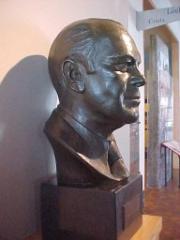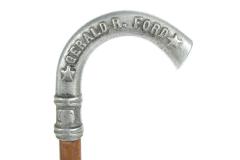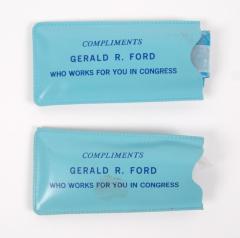Comments and Tags
Be the first to comment on this item!
Letter, Gerald R. Ford
Identifier:
2018.20.8Description:
This letter was written by Gerald R. Ford to the chairs of the Grand Vision Committee (later called Grand Action) of Grand Rapids, Michigan on February 4, 1993. In the letter, he writes of his acceptance of an honorary chair role on the Grand Action Committee as they work to develop plans for the construction of a new arena and expanded convention center (later named the Van Andel Arena and DeVos Place Convention Center). Ford's letter is an important sign of support for the vision that was set forth by the Committee. It is part of a collection of items relating to the work of Grand Action, a not-for-profit organization that led the revitalization of downtown. Grand Action formed in 1991 by Dick DeVos and after successfully meeting their mission, they closed their doors in 2018.Date:
February 4 1993Materials:
PaperDimensions:
8 1/2"" h 6 3/8"" wCurrent Location Status:
In StorageCollection Tier:
Tier 2Source:
Gift of Grand ActionRelated Entities:
Grand Action (donor)Alternate names: Grand Action Committee
Spearheaded and co-chaired by John Canepa, Dick DeVos and David Frey, Grand Action is a not-for-profit organization comprised of more than 250 individuals from throughout the community. Its primary objectives have been to identify downtown building and revitalization projects, to galvanize public opinion and support for these projects, and to design and implement funding strategies for each project, including securing enough private sector support to guarantee funding from existing public funds.
Grand Action is an outgrowth of the Grand Vision Committee, in April 1991 Dick DeVos assembles more than 50 West Michigan community leaders and volunteers from the business, labor, civic, academic and sports sectors to explore the possibility of building an arena and expanding the renovating local convention facilities. A number of subcommittees were formed which met over the course of the next two years. In February 1993, Grand Vision presented results of a comprehensive feasibility study recommending the construction of a 12,000-seat arena and expanded convention facilities in Grand Rapids. In April, 1993, Grand Vision officially changed its name to Grand Action and set-up offices at 120 Lyon N.W. John Canepa and David Frey joined Dick DeVos as Co-chairs of the new organization.
In 2018, Grand Action officially closed their doors, having met their mission. For the full backgrounder on the organization detailing the different phases of Grand Action, including the completion of the Van Andel Arena (1996), DeVos Place (2005), Michigan State University College of Human Medicine (2010), renovation of Civic Theatre (2005) and the Downtown Market (2013) see the attached documents. Gerald R. Ford (creator)
Alternate names: Leslie Lynch King Jr.
Gerald R. Ford was born Leslie Lynch King, Jr., in Omaha Nebraska to Dorothy Ayer Gardner and Leslie Lynch King, Sr. In 1913, his mother moved with him to her parents’ home in Grand Rapids, Michigan, and in that same year she gained full custody of her son. In 1916, Dorothy remarried Gerald Rudolff Ford, and in 1935, though not formally adopted, Leslie Jr. legally changed his name to Gerald Rudolff Ford, Jr.
Ford was a member of The Boy Scouts of America, and is the only U.S. President to become an Eagle Scout. He grew up in the Heritage Hill neighborhood of Grand Rapids and attended Grand Rapids South High School. As a star athlete, he was captain of his football team and was selected for the All-City Team. He was later recruited by the University of Michigan’s football team and played for the school in the 1930-1934 seasons. After graduating in the spring of 1935 with a degree in economics, he received offers from the Detroit Lions and the Green Bay Packers. Instead, he took a coaching position at Yale and attended law school there. He graduated in 1941 and was admitted to the Michigan bar association that year.
After his schooling, Ford became an ensign in the U.S. Naval Reserve. He served from 1942-1946. He moved quickly through the ranks and resigned in 1946 as a Lieutenant Commander. He received the Asiatic-Pacific Campaign Medal with nine engagement stars for his service, as well as the American Campaign and World War II Victory Medals. He returned to Grand Rapids after his service. In 1948, Ford married Elizabeth “Betty” Bloomer Warren at Grace Episcopal Church in Grand Rapids. They had four children: Michael, John, Steven, and Susan.
Ford was heavily involved in local Republican politics following his military service. He was elected to the U.S. House of Representatives in 1949 and served there for 25 years, becoming House Minority Leader in 1965. In 1973, after Vice President Agnew resigned, President Nixon appointed Ford as his new Vice President. Less than a year later, in 1974, Nixon also resigned, making Ford President of the United States.
One of Ford’s first acts as president was the controversial pardoning of Nixon, issued in Proclamation 4311. Shortly after, he attempted to pardon Vietnam War “draft dodgers” through an amnesty program that required reaffirmation of allegiance and two years of public service work. Ford’s presidency was plagued with problems, including the end of the Vietnam War and the federal deficit that continued throughout his term. It is because of these problems and Ford’s pardons that he faced two assassination attempts in 1975. It is also likely the result of these issues that caused Ford to lose the 1976 presidential election to Jimmy Carter.
After his presidency, Ford published his autobiography, A Time to Heal, and an anecdotal book, Humor and the Presidency. He maintained a friendship with his successor, Carter, and visited Washington often. He remained active in Republican politics, though being a vocal opponent to conservative colleagues’ anti-LGBT opinions and the war in Iraq.
At the 2000 Republican National Convention, Ford suffered two minor strokes. This triggered a slow decline in the president’s health and on December 26, 2006, Ford died in his home in Rancho Mirage, California, of coronary artery disease. He was 93 years old. His funeral and memorial services were held at the National Cathedral in Washington, D.C., and he was buried at the Gerald R. Ford Presidential Museum in Grand Rapids, Michigan. Gerald R. Ford (is related to)
Alternate names: Leslie Lynch King Jr.
Gerald R. Ford was born Leslie Lynch King, Jr., in Omaha Nebraska to Dorothy Ayer Gardner and Leslie Lynch King, Sr. In 1913, his mother moved with him to her parents’ home in Grand Rapids, Michigan, and in that same year she gained full custody of her son. In 1916, Dorothy remarried Gerald Rudolff Ford, and in 1935, though not formally adopted, Leslie Jr. legally changed his name to Gerald Rudolff Ford, Jr.
Ford was a member of The Boy Scouts of America, and is the only U.S. President to become an Eagle Scout. He grew up in the Heritage Hill neighborhood of Grand Rapids and attended Grand Rapids South High School. As a star athlete, he was captain of his football team and was selected for the All-City Team. He was later recruited by the University of Michigan’s football team and played for the school in the 1930-1934 seasons. After graduating in the spring of 1935 with a degree in economics, he received offers from the Detroit Lions and the Green Bay Packers. Instead, he took a coaching position at Yale and attended law school there. He graduated in 1941 and was admitted to the Michigan bar association that year.
After his schooling, Ford became an ensign in the U.S. Naval Reserve. He served from 1942-1946. He moved quickly through the ranks and resigned in 1946 as a Lieutenant Commander. He received the Asiatic-Pacific Campaign Medal with nine engagement stars for his service, as well as the American Campaign and World War II Victory Medals. He returned to Grand Rapids after his service. In 1948, Ford married Elizabeth “Betty” Bloomer Warren at Grace Episcopal Church in Grand Rapids. They had four children: Michael, John, Steven, and Susan.
Ford was heavily involved in local Republican politics following his military service. He was elected to the U.S. House of Representatives in 1949 and served there for 25 years, becoming House Minority Leader in 1965. In 1973, after Vice President Agnew resigned, President Nixon appointed Ford as his new Vice President. Less than a year later, in 1974, Nixon also resigned, making Ford President of the United States.
One of Ford’s first acts as president was the controversial pardoning of Nixon, issued in Proclamation 4311. Shortly after, he attempted to pardon Vietnam War “draft dodgers” through an amnesty program that required reaffirmation of allegiance and two years of public service work. Ford’s presidency was plagued with problems, including the end of the Vietnam War and the federal deficit that continued throughout his term. It is because of these problems and Ford’s pardons that he faced two assassination attempts in 1975. It is also likely the result of these issues that caused Ford to lose the 1976 presidential election to Jimmy Carter.
After his presidency, Ford published his autobiography, A Time to Heal, and an anecdotal book, Humor and the Presidency. He maintained a friendship with his successor, Carter, and visited Washington often. He remained active in Republican politics, though being a vocal opponent to conservative colleagues’ anti-LGBT opinions and the war in Iraq.
At the 2000 Republican National Convention, Ford suffered two minor strokes. This triggered a slow decline in the president’s health and on December 26, 2006, Ford died in his home in Rancho Mirage, California, of coronary artery disease. He was 93 years old. His funeral and memorial services were held at the National Cathedral in Washington, D.C., and he was buried at the Gerald R. Ford Presidential Museum in Grand Rapids, Michigan.



